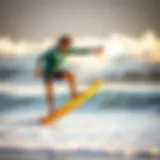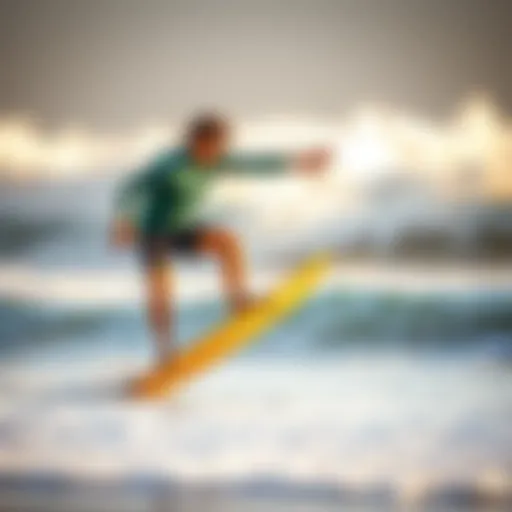Exploring Non Electric Foil Boards: A Comprehensive Guide
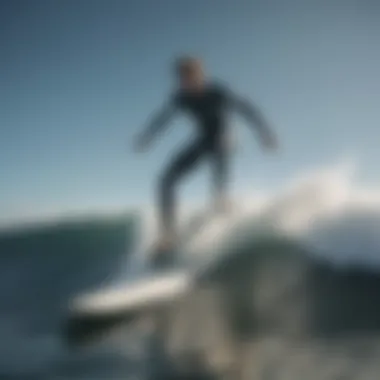

Intro
In recent years, non-electric foil boards have gained traction among surfboarding enthusiasts, shifting perceptions and sparking curiosities in the water sports community. These boards, which are powered solely by the rider's skill and the wind, provide a unique, almost ethereal experience as they glide over the waves. Whether you’re a novice seeking thrills or an experienced surfer aiming to push your limits, understanding these boards is integral to enhancing your surfing journey.
The appeal lies not only in the mechanics and capabilities of foil boards but also in the sensation of riding above the water. Picture yourself hovering just above the ocean’s surface, feeling every swell and current beneath you. It’s a blend of adrenaline and tranquility, offering a refreshing alternative to traditional surfing. To truly grasp the wonders of non-electric foiling, one must explore various aspects—from surfing techniques to gear recommendations and even maintenance tips. This guide aims to encapsulate this thrilling world, helping both newcomers and veterans navigate their way through.
As we dive deeper into the intricacies of non-electric foil boards, we will shine a light on various essentials your surfboard journey could benefit from.
Surfing Techniques
Catching waves on a foil board requires a keen understanding of both techniques and the aquatic environment. Let’s detail two important categories here.
Advanced Maneuvers for Experienced Surfers
For those seasoned in the art of foiling, there’s a treasure trove of advanced techniques to master. Some key maneuvers include:
- Carving Turns: Utilize the board's lift to initiate smooth, sweeping turns. Shift your weight subtly to influence the board’s angle.
- Jumping: This exhilarating maneuver demands both confidence and precision. Timing the jump with an incoming wave can create stunning aerial moments.
- Tail Slides: By shifting your weight aft while rotating, the back of the board will slide, allowing for impressive tricks that captivate spectators.
Refining these techniques undoubtedly enhances your surfing experience, elevating both personal enjoyment and performance.
Beginner Tips for Catching Your First Wave
For those just starting out, the ocean may seem a daunting place filled with unpredictable waves and untamed waters. Consider these essential tips:
- Positioning: Your stance on the board matters immensely. Stay balanced and centered. Keep your knees slightly bent to absorb the wave's energy.
- Wave Selection: Start with smaller, gentle waves; they’re more forgiving and allow you to focus on your technique without overwhelming you.
- Practice Makes Perfect: Don’t rush the learning process. Spend time getting comfortable on flat water to familiarize yourself with board dynamics before tackling waves.
These initial steps lay a strong foundation for your foiling adventures, enabling you to build confidence and master new skills.
"Patience is key in learning. The ocean rewards those who take their time to understand her."
Gear and Equipment Reviews
Selecting the right gear can significantly impact your foiling experience. Here we review key equipment and accessories essential for every surfer’s toolkit.
In-Depth Review of the Latest Surfboards
When it comes to non-electric foil boards, various models flood the market. One standout, the Slingshot Hover Glide, has gained praise for its stability and responsiveness. Designed with a focus on versatility, it suits both flatwater and wave riding.
Another option, F-One Phantom, showcases an impressive glide and easily navigates choppy waters, making it excellent for intermediate surfers.
Each of these boards comes with its own set of features and unique advantages that cater to different surf styles and rider preferences.
Essential Accessories Every Surfer Should Have
To maximize your surfboarding experience, don’t overlook the importance of the right accessories. Among must-have items are:
- Leash: A durable leash keeps your board tethered during wipeouts.
- Paddle: Particularly for non-electric models, a good-quality paddle can aid in maneuvering and stability.
- Safety Gear: Helmets and impact vests provide essential protection, especially for inexperienced surfers navigating through challenging conditions.
In all, equipping yourself with the right gear and profoundly understanding the techniques of non-electric foiling can transform your surfing experience dramatically. As we further unravel this guide, readers will be invited to embrace the artistry of foiling—a blend of science, skill, and, ultimately, the joy of riding the waves.
Foreword to Non Electric Foil Boards
The rise in popularity of non-electric foil boards marks a significant shift in the surfing landscape. This article seeks to demystify these boards, focusing on their unique characteristics and what makes them a compelling alternative to traditional surfboards.
In an age where technology dominates many outdoor activities, non-electric foil boards provide a refreshing escape, allowing surfers to connect more profoundly with nature while enhancing their riding experience. When you think about gaining that elusive sense of freedom on the water, non-electric foil boards often come to mind. Their design emphasizes not just performance but also an eco-friendlier approach to surfing, which is increasingly important to many riders today.
Defining Non Electric Foil Boards
Non-electric foil boards are watercraft that utilize a hydrofoil to lift above the water's surface, providing a smooth ride with less drag. Unlike their electric counterparts, these boards rely solely on the rider's skill and the energy generated by the waves, making them a more sustainable choice.
Typically made from materials like carbon fiber or fiberglass, non-electric foil boards are lightweight yet sturdy. Their construction allows for easy movement and agility, enabling surfers to cut through water with precision. This unique setup invites a more intuitive riding experience, fostering a deep sense of connection with the ocean.
Understanding the Mechanics
To grasp the full potential of non-electric foil boards, one must understand the mechanics at play. At the heart of the system is the hydrofoil, which consists of a wing-like structure submerged beneath the water. As the surfer gains speed, water flows over the foil, creating lift. This lift raises the board and the rider above the water, significantly reducing resistance and allowing for greater speeds and smoother rides.


The angle of the board relative to the water, known as the angle of attack, is crucial for maintaining flight. Riders can adjust this based on their skill level and the conditions of the water. Unlike traditional surfboards that are heavily influenced by wave size and strength, non-electric foiling provides a greater margin for enjoyment across a wider range of conditions, making it accessible to many.
"For those who’ve never tried it, foiling feels like dancing on water; it’s an elevation of the sport that brings the ocean to your feet."
Through a better understanding of these mechanics, surfers can appreciate how non-electric foil boards function, leading to improved control and confidence on the water. This exploration of the topic sets the stage for a deeper dive into the benefits of these boards, their construction, and what to look for if you decide to take the leap into the world of non-electric foiling.
Benefits of Non Electric Foil Boards
When it comes to the world of water sports, non-electric foil boards are making quite the splash, and for good reason. This section digs into the essential advantages of these boards, providing a panorama of why more surfers are opting for non-electric over traditional options. From practical considerations such as control and environmental impacts to less obvious perks like maintenance ease, these benefits paint a vivid picture of what makes non-electric foil boards a wise choice for both novices and experienced riders alike.
Enhanced Control and Maneuverability
One of the standout features of non-electric foil boards is their remarkable control and agility on the water. Unlike electric alternatives, which often feel bulky and less responsive, non-electric boards emphasize rider connection with the surf. The absence of an electric motor means that surfers get direct feedback from the board, facilitating smoother transitions with every carve and turn. This heightened sense of control can be likened to the difference between driving a manual versus an automatic vehicle—there’s a certain elegance to managing the foil that offers a heightened surfing experience.
"Riders frequently recommend non-electric foil boards for their direct communication with the waves, which in turn builds confidence and enhances overall enjoyment."
Surfers often cite improved maneuverability when navigating tricky waves. The weight distribution and streamlined design of non-electric boards allow for quick adjustments, which can be crucial in dynamic conditions. Moreover, mastering basic techniques on these boards tends to translate seamlessly into skills on other surf disciplines. Riders can achieve tighter turns and a more fluid surfing style, feeling as if they are dancing on water—this is a sensation that can be incredibly rewarding and satisfying.
Eco-Friendliness
In a world increasingly dominated by the need for sustainability, non-electric foil boards offer a greener alternative. These boards rely solely on wave energy and the rider’s skill, avoiding the environmental impact linked with battery production and electric motors. Considering the pollution that is often tied to electric equipment, it’s refreshing to see a sport that aligns more closely with eco-friendly principles.
Additionally, many manufacturers of non-electric foil boards are opting for sustainable materials in their production processes. This isn’t just an afterthought; it’s a fundamental aspect of their philosophy. Riders are not only enjoying their time on the water but are actively participating in a movement towards cleaner oceans and sustainability practices. This resonates well beyond the surfing community, tapping into a broader environmental consciousness that is becoming increasingly vital in today’s world.
Simplified Maintenance
For many, maintenance can be a daunting aspect of owning board sports equipment, but non-electric foil boards cut down on those concerns significantly. They boast simpler designs with fewer moving parts. Without an electric motor, the chances of mechanical failure drop dramatically, ultimately lowering repair costs and time spent maintaining the gear.
When it comes to cleaning, a quick rinse after hitting the surf usually suffices to keep the board in top shape. Unlike electric boards that may have hidden compartments and wires to manage, the straightforward structure of non-electric boards ensures that maintenance is as easy as pie.
For serious enthusiasts, this means more time riding waves and less time in the workshop. Riders can focus on honing their skills and enjoying the ocean instead of worrying if their equipment is up to scratch.
In summary, the benefits of non-electric foil boards span multiple aspects, from enhanced control and a unique ride quality to a commitment to eco-friendliness and ease of upkeep. This convergence of features not only improves the surface experience for various levels of surfers but also inspires a richer connection with the ocean itself.
Choosing the Right Non Electric Foil Board
Selecting the right non-electric foil board is crucial for both performance and enjoyment, especially if you're navigating the diverse world of foiling. A good board not only encourages progression in skills but also enriches your overall experience on the water. Each decision you make—be it size, material, or design—can significantly affect your ride and how well you connect with the elements.
Board Size and Weight Considerations
Factors Influencing Size
When it comes to size, a few elements come into play. Generally, a larger board offers stability, making it ideal for beginners or heavier riders. However, it may sacrifice some responsiveness. A smaller board, while less stable, can provide a more dynamic experience for skilled users. Another important aspect is the height and weight of the rider; these factors influence how the board behaves in the water. For instance, a taller person may prefer a larger board to accommodate their balance better.
Choosing the right size impacts your maneuverability and overall comfort on the water.
The uniqueness of this consideration lies in how personal preferences intersect with structural performance. Ultimately, finding a sweet spot that balances size with the rider's style opens up the potential for an enjoyable ride.
Weight Considerations for Performance
The weight of the board also plays a role in performance, particularly during takeoff and landing. Lighter boards require less effort to get into the air, allowing for quicker transitions. However, they may be more prone to damage without proper care. Conversely, heavier boards often provide stability but can be cumbersome, especially in choppy waters. These factors become crucial when deciding which board suits your style.
Materials and Construction
Differences in Materials
There are several materials used in the construction of non-electric foil boards, each with its own pros and cons. Common materials include fiberglass, carbon fiber, and foam. Fiberglass offers a balance of durability and flexibility, making it a popular choice among many riders. On the other hand, carbon fiber, while more expensive, provides unparalleled strength and lightness, which can enhance performance.
The choice of material can greatly influence the ride experience, with different options catering to various skill levels and preferences. So, it’s worth considering which material aligns best with your surfing style and expectations.
Durability Considerations
Durability is a key concern as well. Boards made from more robust materials tend to withstand wear and tear, which is vital for long-term investment. For example, a board built with high-quality fiberglass can endure the rigors of regular use without succumbing to damage easily. However, affordable options can save you money upfront but might lead to costly replacements down the line.
Ultimately, investing in a board that's built to last will pay off, as it means less time worrying about repairs and more time enjoying your surfing.
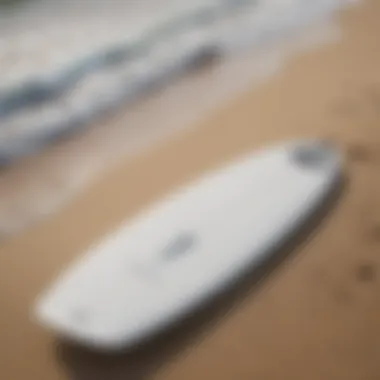

Design Features to Look For
Cut and Shape Variations
The cut and shape of a foil board can drastically affect how it performs in the water. Different designs offer unique traits, from straight-edged boards that cut through waves easily to rounded edges that enhance maneuverability. Selecting the right shape greatly influences your comfort level and capability on the water.
Each variation has its own benefits; for instance, a board with a full nose might offer better buoyancy for beginners, whereas experienced riders may opt for a tapered nose for agility. Discovering what works best for you often comes down to trial and error, informing future choices.
Fin Configuration
Fin configuration is another critical aspect to take into account. The arrangement of fins can influence stability and control, which are key in different water conditions. A single fin setup typically provides a more stable ride, making it favorable for beginners. Meanwhile, multi-fin designs can offer greater control and maneuverability, catering to advanced riders who want to push their limits.
The choice between configurations should reflect the conditions you expect to encounter, as well as your personal riding style. Thoughtful consideration of these design elements will enhance your connection with the water.
Finding the right non-electric foil board may seem daunting, but pinpointing variables such as sizing, material, and design can lead to a board that complements your personal riding style, ultimately enhancing your experience on the waves.
Comparing Non Electric Foil Boards to Traditional Surfboards
When looking at the world of surfing, one must consider how non-electric foil boards stand alongside traditional surfboards. This comparison provides valuable insights into performance, ease of use, and the overall surfing experience. While both options variate in design and function, understanding their distinctive characteristics can guide surfers towards a more informed choice.
Performance Metrics
Speed and Glide Comparison
Taking into account speed and glide, non-electric foil boards often offer a different experience than traditional boards. One of the key characteristics is the way they effortlessly skim across the water. The hydrofoil mechanism in these boards lifts them above the surface, reducing drag and allowing for astonishing speeds. This swift gliding sensation is something many riders find particularly appealing.
The unique feature of the foil design is its ability to catch speed with less effort. Compared to a conventional surfboard, which requires the rider to pump their body for momentum, a foil board rides the waves with minimal input. This might sound ideal, however, it requires a different technique that not everyone may grasp immediately. It's a beneficial aspect for seasoned surfers who crave that adrenaline rush but can be a learning curve for novices.
Catch Potential of Waves
The catch potential of waves also differs markedly between non-electric foil boards and their traditional counterparts. A foil board's design allows it to catch waves earlier, thanks to its lift. Its hydrodynamic feature enhances the ability to ride small swells that typical surfboards might miss.
While this characteristic makes foil boards appealing, there are hesitations. The unique feature of riding higher in the water can lead to a less stable experience, especially in choppy conditions. Surfers need to adapt to how waves interact with the foil, which could be rather challenging for some. Hence, while the catch potential is a significant advantage, it does come with its own set of considerations.
Learning Curve Differences
Transitioning from a traditional surfboard to a non-electric foil board presents a noticeable learning curve. For many surfers, the familiar action of paddling and popping up on a wave is ingrained in muscle memory. However, foil boards require an entirely different approach to balance and throttle control. Riding higher off the water means surfers need to adjust to a new feeling, which can lead to an initially awkward experience.
Being comfortable on a foil involves mastering weight distribution and timing. These would-be riders aren’t just learning to glide but to dance amid waves. Making the switch can feel, at times, like learning to walk again. Although some find it a refreshing challenge that enhances their surfing skills, others may feel frustrated and even abandon the sport altogether.
User Insights and Expert Opinions
Understanding how a product is received by its users and esteemed by professionals is crucial for anyone looking to buy non-electric foil boards. This section delves into two critical elements: the experiences shared by riders who have taken these boards into the water and the assessments made by experts in the field. Both facets provide invaluable information that can help potential buyers make informed decisions.
Rider Experiences
Rider feedback tends to form the backbone of any discussion surrounding non-electric foil boards. Every surfer has a unique story, shaped by skill level, wave conditions, and the specific board they chose. The thrill of hovering above the water, feeling every ripple and swell, creates a bond between the rider and their board that can't be measured by statistics alone.
When riders share their experiences, they often highlight several key aspects, such as:
- Stability and Balance: Experienced surfers often mention how certain non-electric foil boards give them a serene sense of stability. It usually addresses the fears of beginners who may feel unsure of their balance on the board.
- Efficiency in Various Conditions: Many riders discuss how some boards outperform others in different water conditions. Experienced surfers might suggest that a specific design could handle choppy waves better than others.
- Sensory Feedback: The sensation of gliding over water without the mechanical noise of an electric motor is praised by many riders. They say it's akin to flying, giving them freedom and an enhanced connection with the ocean.
Reading these firsthand accounts can unearth practical insights by revealing how the boards truly perform in real-life situations, allowing enthusiasts to choose a board that caters to their unique riding style.
"Every ride tells a story, and each board carries its own legend aboard the waves."
Expert Reviews and Recommendations
Expert opinions stand on rigorous evaluation, taking into consideration technical aspects, materials, and the overall riding experience. Properly analyzed insights from professionals in the surfing community can offer a wealth of knowledge. They back their recommendations with data, ensuring buyers don’t settle for just any old board but a model that matches their needs and expectations.
A few areas where expert reviews provide clarity include:
- Performance Ratings: Experts often provide numerical ratings on speed, maneuverability, and the learning curve associated with specific boards, arming riders with quantifiable data to aid in their choices.
- Brand and Model Comparisons: Reviews closely discuss how various brands stack against one another in terms of design innovations and user friendliness. They often point out flagship models that withstand the test of time, noting both pros and cons.
- Advice on Selection: Experts frequently recommend boards suited for specific skill levels, ensuring beginners don't bite off more than they can chew. This guidance can drastically reduce the time it takes to acclimate to non-electric foiling.
Understanding what seasoned experts and experienced riders have to say about non-electric foil boards can allow prospective buyers to skip pitfalls often faced by novices. Knowledge is a powerful tool, especially when it comes to making significant investments in surfing equipment.
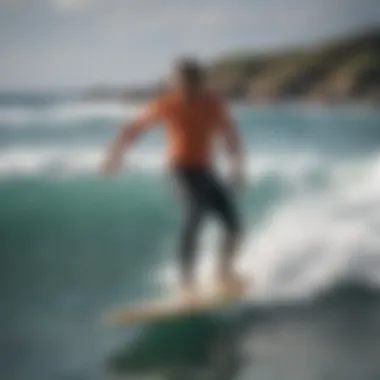

Maintenance and Care for Non Electric Foil Boards
Taking care of non electric foil boards is crucial if you want to prolong their lifespan and maintain performance. Unlike traditional boards, which might be more forgiving, these boards rely heavily on their precise design and materials. So, let’s break down the essentials.
Cleaning and Storage Tips
First off, cleaning your board after each use can go a long way. Sea salt, dirt, and sand can be abrasive, decreasing the board’s durability. Here’s how you can keep it in tip-top shape:
- Rinse with Fresh Water: After a session, give your board a good rinse with fresh water. This helps remove salt and sand that can eat away at the finish.
- Soft Cloth Wipe Down: Use a soft cloth to wipe the surface gently. This prevents scratches that can create wear over time.
- Store Upright: When storing, try to keep the board upright, ideally in a board bag. This minimizes pressure on the fuselage and wings.
Storing it in a cool, dry place is also vital. UV rays can degrade materials, so avoid direct sunlight wherever possible.
Preventative Maintenance Practices
To avoid mishaps on the water, it’s wise to be proactive about maintenance. Here are some practices that can save you from sudden repairs or replacements:
- Regular Inspections: Check screws, mounts, and wings regularly. Any loose parts can lead to failures while riding.
- Sealant Applications: If your board is susceptible to water ingress, applying a sealant on the edges can provide an added layer of protection.
- Tight Neckting: Ensure straps and fittings are secured. A loose strap can lead to dangerous situations when riding.
- Avoid Collisions: Where possible, stay clear of sharp objects or large waves that can damage your board in an instant.
To sum it up, taking time for cleaning and maintenance elevates your riding experience and keeps your non electric foil board ready for action.
Remember: Regular care not only enhances performance but also allows you to enjoy your experience with peace of mind, knowing your gear is in top shape.
Emerging Trends in Non Electric Foiling
As the enthusiasm for non-electric foil boards continues to swell, emerging trends are shaping the future of this sport. These shifts are not only influencing designs and performance but also fostering a sense of community and shared experiences among riders. Understanding these trends helps enthusiasts stay ahead of the curve, making it essential for both seasoned and novice surfers alike.
Innovations in Design and Technology
New technologies and creative designs are sprouting up in the world of non-electric foiling. For instance, manufacturers are experimenting with different materials to enhance the board's performance. Carbon fiber, for instance, is gaining popularity due to its lightweight and durability, providing riders with optimal control without sacrificing strength.
Another striking trend is the focus on hydrofoil shape optimizations. The evolution of wings—changing their size, aspect ratio, and camber—has proven to significantly impact lift and drag characteristics. This advancement allows surfers to catch waves more easily and glide smoothly without as much effort. The customization options available today mean that every rider can find a board that fits their personal style and skill level, enhancing their overall experience on the water.
Moreover, technological integration is becoming more common. Some boards come equipped with speed indicators or GPS tracking, giving riders insights about their performance and efficiency. This data helps to make informed adjustments and encourages the pursuit of excellence in their foiling journey.
Community Growth and Events
The sense of community in the non-electric foiling realm has burgeoned immensely in recent years. Local meetups, competitions, and workshops are organizing at an increasing pace, enabling riders to connect, share tips, and have fun. This growth isn't just beneficial for individual surfers; it fosters a culture of inclusivity.
Being part of a supportive community can dramatically enhance one’s skill. As riders gather for events, they not only showcase their skills but also learn from each other in a lively exchange of techniques and experiences. These gatherings often lead to collaborative learning and a deeper appreciation of the sport.
Additionally, the rise of online platforms on sites like Reddit and Facebook has allowed for extensive dialogue among enthusiasts. Discussions range from gear recommendations to travel destinations ideal for foiling, creating a treasure trove of information.
"The moment I tried foiling, I knew I found my tribe. It’s not just about the ride; it’s about the people sharing the waves with you."
— A seasoned non-electric foil rider.
The increasing accessibility of events invites participation from all walks of life and elevates the sport into a more mainstream consciousness. It’s no longer solely a niche activity; it’s becoming an exhilarating lifestyle shared between passionate individuals.
End
In wrapping up our exploration of non-electric foil boards, it’s important to emphasize the manifold elements that converge to make them a noteworthy choice for both seasoned surfers and newcomers. This guide has unearthed several key insights, rendering the topic not just a niche interest but a compelling way to engage with the water. The mechanics delve into their performance benefits while also recognizing how they stand out in the larger context of surf culture. These boards steer away from the noise of electric options, embracing simplicity and connection with nature.
Recap of Key Points
The profound benefits of non-electric foil boards have been highlighted throughout the article:
- Mechanics and Maneuverability: With the straightforward design, these foil boards offer agility and responsiveness, which is critical when gliding over waves.
- Eco-consciousness: In today’s world, reducing our carbon footprint is paramount, and non-electric foiling contributes to this sustainable lifestyle.
- Simplicity in Maintenance: They are easier to care for than their powered counterparts, allowing more time on the water rather than tinkering with machinery.
- Community Engagement: As more people take to non-electric foiling, a vibrant community is forming, offering knowledge sharing and camaraderie.
Overall, these boards are not merely functional; they are an extension of one’s ethos towards surfing and environmental stewardship.
Future of Non Electric Foil Boards
Looking ahead, the future of non-electric foil boards appears promising. The wave of sustainable practices in industries worldwide is prompting manufacturers to innovate continually. Here are a few emerging trends:
- Material Advancements: Expect developments in lighter and more sustainable materials that enhance performance while diminishing the environmental impact.
- Design Innovations: New designs are constantly adopted, focusing on improved stability and speed, attracting a wider array of users, from casual surfers to competitive riders.
- Community Expansion: The fusion of recreational surfing with competitive events focused solely on non-electric foiling may spark a broader movement, gathering increased attention from sponsors and spectators alike.
- Education and Awareness: As the non-electric foil community grows, there’s a rising need for workshops and educational programs, fostering skilled riders who appreciate both the sport and its sustainable aspects.
In summary, non-electric foil boards are positioned to continue gaining traction, offering freedom and an exhilarating connection with the elements. As we advance, the synergy of innovation, community, and environmental consciousness will likely pave the way for an exciting new chapter in the world of surfing.
"Simplicity is the ultimate sophistication." – Leonardo da Vinci
The interaction with the natural water environment resonates through every wave ridden, every technique mastered, and every community event celebrated.
For more insights on surfing culture and technology, check resources at Britannica or discussions on Reddit and Facebook.


